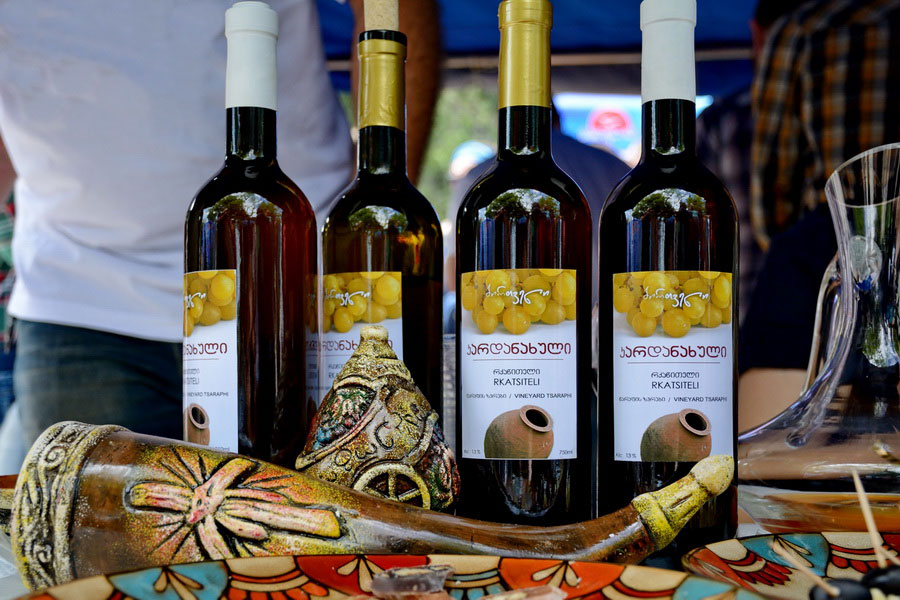Georgian Wines

“Georgian wines” is a phrase which may sound like a brand, for wine in Georgia is a brand, as well as an invaluable part of local culture and a vital sector of the Georgian economy. As Georgia and wine are inseparable, any travel guide will insist that tasting this drink when visiting is an absolute must. Wine itself is diverse - it may be red or white, sweet or acidic, strong or subtle, new or aged - but the uniqueness of Georgian wine sets it apart in a class entirely its own.
And just what makes Georgian wines so special? Grapes, of course! Grape varieties have a huge impact on the taste of wine, which is why, for example, the wines of Argentina and France are so different from one another. Armenia’s extra sweet grapes produce strong, sweet wines, although such grapes are actually ideal for making cognac, not wine. Interestingly, even a specific grape variety will grow differently in different countries due to climate and topography. As an example, Saperavi wine from Georgia’s Kakheti Region and Saperavi wine produced from grapes grown elsewhere will be very different from one another.
Grape varieties are divided into black and white according to the color of the skin, with Saperavi, Mtsvane, Chinuri, Rkatsiteli, Aleksandrouli and Tsolikauri among the most famous kinds in Georgia. In total there are 525 known endemic grape varieties in Georgia. Their uniqueness lies in the fact that they were not imported but have always grown here, first in the wild and then on cultivated lands, thus giving shape to centuries of Georgian wine history. In Georgia, grapes grow on the plains and in the foothills, with more than 75% of all Georgian grapes found in Kakheti Region.

Yet Georgia’s unique and diverse grapes are not the only reason why Georgian wines differ from others. Georgia also employs special winemaking technologies, with the three main methods being European (classical), Kakhetian and Imeretian.
The European or classical method involves storing the grapes in “satnakheli”, large wooden containers made from peeled twigs. The grapes are then crushed with bare feet and the juice separated from the peels and seeds before fermentation. This method was used in ancient Greece and Rome and was first introduced to Georgia by Alexander Chavchavadze in the 19th century. Today it is also used in France and other countries which imitate the French method of wine production. The classical method results in a low-astringency wine with a very even taste.
For the Kakhetian method of winemaking, the seeds and crushed grapes are not separated from the juice. Instead, all is placed together in a special ceramic vessel called qvevri, which is then buried for 3-6 months. The Kakhetian method often produces an orange or Georgian amber wine with a tart and full-bodied taste. Compared to European varieties, Kakhetian wines contain a higher percentage of antioxidants and polyphenols, both of which are beneficial to one’s health.
The Imeretian method of winemaking combines European and Kakhetian techniques by adding 15-25% of the extracts (crushed grapes with seeds) to the kvevri vessels. This wine is distinguished by its higher acidity, lower astringency and smoother taste.

Interesting Facts about Georgian Wine:
- In Georgia, wines may be produced either from one grape variety (Saperavi, Kindzmarauli, Akhasheni, Mtsvane, Rkatsiteli, Kisi, Usakhelouri, etc.) or by combining different varieties. For example, in Racha the famous Khvanchkara wine is made from Alexanduli and Mujuretuli varieties, white in Tsinandali the Rkatsiteli and Mtsvane grapes are often paired. In western Georgia an ensemble of three white grape varieties -Tsitska, Tsolikauri and Krakhuna - is popular.
- Ceramic qvevri vessels used to ferment Georgian wine are gradually being replaced with more practical metal vessels, an alteration which is affecting the flavor of the wine.
- The word "saperavi" means something with which to paint or to dye. Compared to the average red grape variety, the color of the saperavi grape is indeed intensely red and is known for producing one of the top 10 Georgian wines.
- The stronger the astringency of Georgian wine, the more polyphenols and tannins it contains and thus the more beneficial it is for your health (in reasonable quantities, of course).
- Georgian wines include many red, white, rose and amber varieties, yet contrary to popular belief the color of the wine does not depend on the color of the grape. Grape juice itself has no color, and the tint instead comes from the coloring substances in the peel. If the juice is separated from the pulp during the first fermentation, black-skinned grapes can actually produce white wine!
With wine now a full-fledged attraction in Georgia, the popularity of wine tours has soared. The most popular destination for wine tours is, of course, Kakheti Region, which is known for its many wineries and diverse wine types. Wine tours are usually focused on either commercial or family wineries, yet a combo tour to both types of establishments is also possible. Wine tasting is a great way to get acquainted with famous local wines while soaking in Georgia’s natural and architectural beauty. September, when the grape harvest holiday of Rtveli takes place in Georgia, is the ideal month for a wine tour.
More about Georgian wine:
Georgian Winemaking Technology
Traditions of Georgian Wine
Georgian Wine Types

